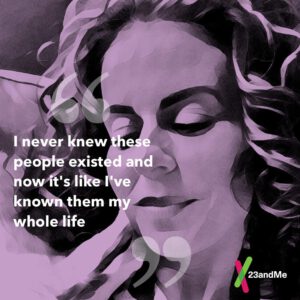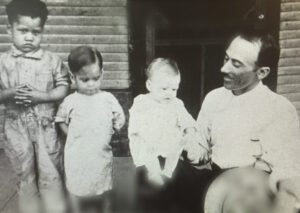Maria felt conflicted.
Here she was celebrating her parents’ 63rd wedding anniversary, and the last thing she wanted to do was upset her elderly mother. But on the flipside she had to ask her.
Maria now knew her mother’s secret, a secret that brought up many questions, serious questions. Maria wanted to know why her mother hid her true origins. Maria wanted to ask those questions and so many more, and her mother was the only one who could answer them.
“So I said to myself: ‘If she mentions the necklace, I’m going to say something,’” said Maria, a mother of young twins who lives with her husband in New Jersey.
A Mother’s Secret
Her parents had come back to New Jersey for their anniversary celebration. The couple met in New York City at a high school dance. Maria’s mom was 18 when she married her father. The couple raised four kids together, part of a large extended Italian family. But that large family was all on Maria’s dad’s side of the family. She knew nothing about her mom’s family.
“My mom’s story was that she was adopted and her parents died and she had no siblings,” Maria said.
Her mother told her kids very little about her biological family except to say there was a rumor that they were Italians who’d immigrated through Argentina to the United States.
Yet after testing with 23andMe and seeing her results, Maria discovered that her mother’s story just didn’t add up. Maria was only half Italian, and almost 20 percent African.
“When I saw it at first I was like ‘wait a second!’” Maria said.
She thought it was wrong.
When she told her sisters and brother they were in denial.
“Mom can’t be black?” they said.
Or could she?
Hidden African Ancestry
Both Maria’s sister and brother tested and they too had close to the same percentage African ancestry. So after that initial shock, Maria started to dig a little deeper, connect with cousins found through 23andMe, and that’s how she pieced together her mother’s family story.
The family’s story is surprising, but finding “hidden African ancestry” is much more common than many know. While most African Americans are aware that they have “white” ancestry – a vestige of the ugly history of slavery – fewer “white” Americans know that they may have “hidden African ancestry” in their families. This too is a legacy of slavery and segregation in America. For those families with hidden ancestry, it means that at some point in history someone in their family likely “passed” for white.
Each story is unique but commonly this was to escape the consequences of racism directed at African Americans that limited job and education opportunities.
For Maria learning this about her mother, didn’t so much change her identity as it changed how she looked at her family.
“It’s strange,” Maria said. “I grew up thinking I was one way and actually I’m not who I thought I was.”
Identity
Maria wanted to know why had her mother kept this secret for so long, but before she asked her questions she wanted to be sure, so she dug a little deeper. And then that day at church she said a prayer. She told herself that if her mother asked about the necklace she’d take it as a sign that it was OK to ask her mother.
As they left the church her mother noticed the necklace telling her daughter how much she liked it. Maria took it as a sign to start asking questions.
“It’s your sister’s necklace,” Maria told her mom.”
Her mother, who had always told her children that she’d been an only child, was stunned.
“’My sister? What do you mean my sister?’” Maria’s mother said.
The Great Migration
Maria told her mom whom it had come from and that she had not just found her mother’s sister but connected with a brother and a few more aunts.
Maria had learned that her mother wasn’t of Italian origin, nor was her biological family originally from Argentina, as she’d once told her kids. Her mother was born in Illinois. Her parents were African Americans from Mississippi, and her mother had had at least 19 siblings. Her mother’s family had moved from the Mississippi to Chicago for job opportunities, part of the wave of African Americans to move north in what is called the “Great Migration.”
Maria had learned that at some point her mother and three of her siblings, who could pass for white, moved to New York City. Maria’s mom was 15 at the time. The four siblings used a Latino sounding last name. Over the years they either lost ties or cut off contact with the rest of the family back in Illinois and Chicago. Maria’s mom soon met the man, who would be her husband at a school dance. When they got married it caused another rift in the family. After the marriage, Maria’s mother lost contact with her three siblings in New York.
Maria learned about this from relatives she found through 23andMe. One of the connections she made was with cousins in California who were the children of her mother’s brother.
Siblings Connect After Decades Apart
After making the connection Maria told her mom and together they traveled together to visit her mother’s 96 year-old brother. The two hadn’t seen each other in 64 years. Maria was also able to find two of her mother’s sisters who were still alive. She talks to them weekly and recently traveled to Chicago to meet one of them and her newly found cousins in person. These connections have given Maria a chance to see family photos of her grandparents, her mother as a young woman, as well as aunts and uncles she never knew she had.
“It’s fascinating and crazy,” Maria said. “I never knew these people existed and now it’s like I’ve known them my whole life.”
As for learning about her and her family’s African American ancestry, Maria said it didn’t really change how she thought about herself. It did change how she thought of her family, and the power of being connected to all these family members she never knew before.
“To me it’s an amazing story of a family’s racial divide, but with a very happy ending,” she said.



